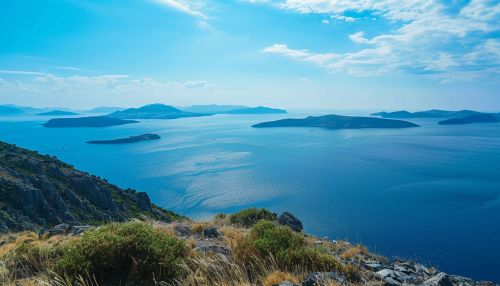Aegean Sea
Geography
The Aegean Sea is an elongated embayment of the Mediterranean Sea located between the Greek and Anatolian peninsulas, i.e., between the mainlands of Greece and Turkey respectively. It covers an area of approximately 214,000 square kilometers. The sea stretches from the southern shores of the Black Sea to the northern coast of the Mediterranean Sea. The Aegean is connected to the Marmara Sea and Black Sea by the Dardanelles and the Bosporus respectively.


The Aegean Sea is characterized by a number of distinct physical and biological features. It is primarily a deep sea, with an average depth of about 1,200 meters, and its deepest point, the Calypso Deep, is about 5,267 meters deep. The sea is also known for its complex archipelago, with over 2,000 islands, the largest of which are Crete, Euboea, Rhodes and Lesbos.
Geology
The Aegean Sea has a complex geological history that dates back to the late Paleozoic era. The sea's current configuration is the result of various geological events including tectonic activity, volcanic eruptions, and sedimentation processes. The Aegean is particularly known for its seismic activity, with numerous active fault lines crisscrossing the region. The most significant of these is the North Anatolian Fault, which has been responsible for several major earthquakes in the region.
Climate
The climate of the Aegean Sea region is typically Mediterranean, characterized by hot, dry summers and mild, wet winters. The sea itself plays a significant role in moderating the climate of the surrounding land areas, with its warm surface temperatures often leading to higher coastal temperatures and humidity levels compared to inland areas. The Aegean is also known for its strong, seasonal winds, the most famous of which is the Meltemi wind, a northerly wind that blows across the sea during the summer months.
Biodiversity
The Aegean Sea is home to a rich biodiversity, with a wide variety of marine species inhabiting its waters. These include various species of fish, such as the Aegean swordfish, tuna, and sardine, as well as a number of invertebrate species, such as the Aegean sea sponge and jellyfish. The sea is also an important habitat for several species of marine mammals, including the Mediterranean monk seal, which is one of the world's most endangered marine mammals.
Human History
The Aegean Sea has a rich human history that dates back to the Neolithic period. It has been a crucial hub for human civilization, particularly during the Bronze Age, when the advanced civilizations of the Minoans on Crete and the Mycenaeans on the Greek mainland flourished. The sea has also played a significant role in the history of the Ancient Greeks, the Romans, the Byzantine Empire, and the Ottoman Empire.
Economy
The Aegean Sea plays a significant role in the economies of Greece and Turkey. It is a major route for international maritime trade, with numerous ports along its coasts, including the major ports of Piraeus in Greece and Izmir in Turkey. The sea is also an important source of food, particularly fish and other seafood, and it supports a vibrant tourism industry, with its beautiful islands and coastal areas attracting millions of visitors each year.
Environmental Issues
The Aegean Sea faces a number of environmental challenges, including overfishing, pollution, and the threat of climate change. These issues have led to significant declines in fish populations and have damaged the sea's delicate marine ecosystems. Efforts are being made to address these issues, including the establishment of marine protected areas and the implementation of sustainable fishing practices.
